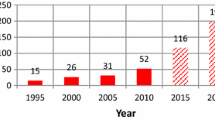Summary
The newly developed light sectioning method has been used to investigate some of the causes and costs of overbreak and underbreak. Investigations at the Aquamilpa Hydroelectric Project in Mexico have shown decreased overbreak and increased underbreak as a result of increased rock quality and decreased explosive energy. A new measure of explosive energy, the ‘perimeter powder factor’ (PPF), has been defined and shown to be useful in the context of tunnel-wall rock damage. Tentative results indicate that explosive energy (PPF) may be a more important factor in producing underbreak, whereas rock quality may be a greater factor in producing overbreak. A site-specific equation is given for predicting overbreak or underbreak as a function of rock quality and explosive energy, with an evaluation of the cost of underbreak and overbreak.
Similar content being viewed by others
References
Abel, J.F. Jr (1982) Average Percentage of Overbreak beyond Payment Line, MN-461 Course Notes, Colorado School of Mines, Golden, CO, USA.
Arnold, A.B., Bisio, R.P., Heyes, D.G. and Wilson, A.O. (1972) Case histories of three tunnel-support failures, California Aqueduct. Bulletin of the Association of Engineering Geologists, 9, 265–99.
Barton, N., Lien, R. and Lunde, J. (1974) Engineering classification of rock masses for the design of tunnel support, Rock Mechanics, 6, 183–236.
Bieniawski, Z.T. (1973) Engineering classification of jointed rock masses, The Civil Engineer in South Africa, 15, 335–44.
Bieniawski, Z.T. (1990) Tunnel Design by Rock Mass Classifications, US Army Corps of Engineers, Washington, DC.
Brekke, T.L. and Selmer-Olsen, R. (1965) Stability problems in underground constructions caused by montmorillonite-carrying joints and faults. Engineering Geology, 1, 3–19.
Butler, A. (1990) CLASSEX: an expert system for rock classification and tunnel design, MSc Thesis, Department of Earth Sciences, University of Waterloo.
Cecil, O.S. (1975) Correlations of Rock Bolt-shotcrete Support and Rock Quality Parameters in Scandinavian Tunnels, Proceedings No. 27, Swedish Geotechnical Institute, Stockholm 1–119.
Clark, G.B. (1981) Basic properties of ammonium nitrate fuel oil explosives (ANFO), Quarterly Journal of the Colorado School of Mines, 76, 1–17.
Deere, D.U. (1964) Technical description of rock cores for engineering purposes, Rock Mechanics and Engineering Geology, 1, 17–22.
Hagan, T.N. (1983) The influence of controllable blast parameters on fragmentation and mining costs, in Proceedings of the First International Symposium on Rock Fragmentation by Blasting, Luleå, Sweden, pp. 31–51.
Holmberg, R. (1979) Design of tunnel perimeter blasthole patterns to prevent rock damage, in Proceedings of the 2nd International Symposium Tunnelling 79, Institute of Mining and Metallurgy, London, pp. 280–3.
Holmberg, R (1983) Hard Rock Excavation at the CSM/OCRD Test Site using Swedish Blast Design Techniques, Columbus, OH.
Isaac, I.D. and Bubb, C. (1981) Geology at Dinorwic, Tunnels & Tunnelling, British Tunnelling Society, 13, No. 3, 20–5.
International Society of Rock Mechanics (1981) Rock Characterization Testing and Monitoring: ISRM Suggested Methods, Pergamon Press, Oxford.
Kaiser, P.K., Mackay, C. and Gale, A.D. (1986) Evaluation of rock classification at B.C. Rail Tumbler Ridge Tunnels, Rock Mechanics and Rock Engineering, 19, 205–34.
Kuzyk, G.W., Lang, P.A. and Le Bel, G. (1986) Blast design and quality control at the second level of atomic energy of Canada's underground research laboratory, in Proceedings of the International Symposium on Large Rock Caverns, Helsinki pp. 147–58.
Langefors, U. and Kihlström, B. (1967) The Modern Technique of Rock Blasting, Almqvist & Wiksell, Stockholm.
Maerz, N.H., Ibarra, J.A. and Franklin, J.A. (1996) Overbreak and underbreak in underground openings Part 1: Measurement using the light sectioning method and digital image processing, Geotechnical and Geological Engineering, 14, 307–323.
Martna, J. (1972) Selective overbreak in the Suorva-Vietas Tunnel caused by rock pressure, in Proceedings of the International Symposium on Underground openings. Lucerne, Switzerland, pp. 141–5.
Martna, J. (1986) The influence of rock structure on the shape and the supports of a large headrace tunnel, in Proceedings of the International Congress on Large Underground Caverns, Firenze, Italy, Vol. 2, pp. 260–9.
Miller, R.P. (1965) Engineering classification and index properties for intact rock, PhD Thesis University of Illinois.
Müller, L. (1959) Der Mehrausbruch in Tunneln und Stollen, Geologie und Bauwesen, Salzburg, Austria, Jg. 24, H. 3–4, pp. 204–222.
Nelson, P. (1983) Tunnel boring machine performance in sedimentary rock, PhD Thesis, Cornell University, NY.
Olofsson, S.O. (1988) Applied Explosives Technology for Construction and Mining, APPLEX, Ärla, Sweden pp. 131–60.
Ontario, Hydro (1983) Darlington GSA Geotechnical Completion Report No. 83543, Darlington Construction and Geotechnical Engineering Department, Toronto, Canada.
Otuonye, F.O., Konya, C.J. and Skidmore, D.R. (1983) Effects of stemming size distribution on explosive charge confinement: a laboratory study, Mining Engineering, 8, 1205–8.
Priest, J.A. and Hudson, S.D. (1981) Estimation of discontinuity spacing and trace length using scanline, International Journal of Rock Mechanics and Mining Science & Geomechanical Abstracts, 18, 183–97.
Rustan, A. (1990) Controlled Contour Blasting of Rock, Division of Mining and Rock Excavation, Technical Report for Luleå University of Technology.
Rutledge, T.C. (1978) Engineering classification of rock for the determination of tunnel support, in Proceedings of the International Tunneling Symposium Tokyo.
Stini, J. (1950) Tunnelbaugeologie, in Die geologischen Grundlagen des Stollen- und Tunnelbaues, Springer-Verlag, Vienna, pp. 14–9.
Thompson, D.E., McKown, A.F., Fourney, W.L. and Sperry, P.E. (1979) Field Evaluation of Fracture Control in Tunnel Blasting, Report 100-79-14, US Department of Transportation, Washington, DC.
Author information
Authors and Affiliations
Rights and permissions
About this article
Cite this article
Ibarra, J.A., Maerz, N.H. & Franklin, J.A. Overbreak and underbreak in underground openings Part 2: causes and implications. Geotech Geol Eng 14, 325–340 (1996). https://doi.org/10.1007/BF00421947
Received:
Accepted:
Issue Date:
DOI: https://doi.org/10.1007/BF00421947




